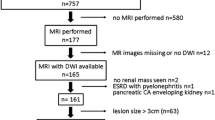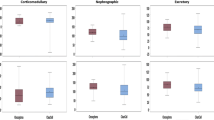Abstract
Objective
Since it has been suggested that benign renal cysts can be diagnosed at unenhanced CT on the basis of homogeneity and attenuations of 20 HU or less, we determined the prevalence of renal cell carcinomas (RCCs) with these characteristics using two different methods of measuring attenuation.
Materials and methods
After IRB approval, two radiologists obtained unenhanced attenuation values of 104 RCCs (mean size 5.6 cm) using a single, large region of interest (ROI), two-thirds the size of the mass. They were then determined if the masses appeared heterogeneous. Of RCCs measuring 20 HU or less, those which appeared homogeneous were re-measured with multiple (6 or more), small (0.6 cm2 or smaller) ROIs dispersed throughout the lesion. Masses with attenuations 20 HU or less were compared to those with masses with HU greater than 20 for any differences in demographic data.
Results
Of 104 RCCS, 24 RCC had HU less than 20 using a large ROI. Of these, 21 appeared heterogeneous and 3 appeared homogeneous. Using multiple small ROIs, these three RCCs revealed maximum attenuation values above 20 HU (Range: 26–32 HU). A greater portion of RCCs measuring 20 HU or less using a large ROI were clear cell sub-type. There were no other differences.
Conclusions
Renal cell carcinoma can measure 20 HU or less at unenhanced CT when a single large ROI is used. While most appear heterogeneous, some may appear homogeneous, but will likely reveal attenuations greater than 20 HU when multiple, small ROIs are used. This knowledge may prevent some RCCs from being misdiagnosed as cysts on unenhanced CT.






Similar content being viewed by others

References
Bosniak MA (1986) The current radiological approach to renal cysts. Radiology 158(1):1–10. doi:10.1148/radiology.158.1.3510019
Silverman SG, Israel GM, Herts BR, Richie JP (2008) Management of the incidental renal mass. Radiology 249(1):16–31. doi:10.1148/radiol.2491070783
Silverman SG, Israel GM, Trinh QD (2015) Incompletely characterized incidental renal masses: emerging data support conservative management. Radiology 275(1):28–42. doi:10.1148/radiol.14141144
Smith RC, Rosenfield AT, Choe KA, et al. (1995) Acute flank pain: comparison of non-contrast-enhanced CT and intravenous urography. Radiology 194(3):789–794. doi:10.1148/radiology.194.3.7862980
Berland LL, Silverman SG, Megibow AJ, Mayo-Smith WW (2014) ACR members’ response to JACR white paper on the management of incidental abdominal CT findings. J Am Coll Radiol 11(1):30–35. doi:10.1016/j.jacr.2013.06.002
Jonisch AI, Rubinowitz AN, Mutalik PG, Israel GM (2007) Can high-attenuation renal cysts be differentiated from renal cell carcinoma at unenhanced CT? Radiology 243(2):445–450. doi:10.1148/radiol.2432060559
Pooler BD, Pickhardt PJ, O’Connor SD, et al. (2012) Renal cell carcinoma: attenuation values on unenhanced CT. AJR Am J Roentgenol 198(5):1115–1120. doi:10.2214/AJR.11.7587
O’Connor SD, Silverman SG, Ip IK, Maehara CK, Khorasani R (2013) Simple cyst-appearing renal masses at unenhanced CT: can they be presumed to be benign? Radiology 269(3):793–800. doi:10.1148/radiol.13122633
Millet I, Doyon FC, Hoa D, et al. (2011) Characterization of small solid renal lesions: can benign and malignant tumors be differentiated with CT? AJR Am J Roentgenol 197(4):887–896. doi:10.2214/AJR.10.6276
Dogra V, Levine E (2003) The kidney. In: Haaga JR, Lanzieri CF, Gilkeson RC (eds) CT and MR imaging of the whole body, vol. vol 2, 4th edn. St Louis: Mosby Inc., pp 1537–1610
Silverman SG, Lee BY, Seltzer SE, et al. (1994) Small (< or = 3 cm) renal masses: correlation of spiral CT features and pathologic findings. AJR Am J Roentgenol 163(3):597–605. doi:10.2214/ajr.163.3.8079852
Schieda N, Vakili M, Dilauro M, et al. (2015) Solid renal cell carcinoma measuring water attenuation (−10 to 20 HU) on unenhanced CT. AJR Am J Roentgenol 205(6):1215–1221. doi:10.2214/AJR.15.14554
O’Connor SD, Pickhardt PJ, Kim DH, Oliva MR, Silverman SG (2011) Incidental finding of renal masses at unenhanced CT: prevalence and analysis of features for guiding management. AJR Am J Roentgenol 197(1):139–145. doi:10.2214/AJR.10.5920
Birnbaum BA, Jacobs JE, Ramchandani P (1996) Multiphasic renal CT: comparison of renal mass enhancement during the corticomedullary and nephrographic phases. Radiology 200(3):753–758. doi:10.1148/radiology.200.3.8756927
Zhang J, Lefkowitz RA, Ishill NM, et al. (2007) Solid renal cortical tumors: differentiation with CT. Radiology 244(2):494–504. doi:10.1148/radiol.2442060927
Ruppert-Kohlmayr AJ, Uggowitzer M, Meissnitzer T, Ruppert G (2004) Differentiation of renal clear cell carcinoma and renal papillary carcinoma using quantitative CT enhancement parameters. AJR Am J Roentgenol 183(5):1387–1391. doi:10.2214/ajr.183.5.1831387
Young JR, Margolis D, Sauk S, et al. (2013) Clear cell renal cell carcinoma: discrimination from other renal cell carcinoma subtypes and oncocytoma at multiphasic multidetector CT. Radiology 267(2):444–453. doi:10.1148/radiol.13112617
Rosenkrantz AB, Matza BW, Portnoy E, et al. (2014) Impact of size of region-of-interest on differentiation of renal cell carcinoma and renal cysts on multi-phase CT: preliminary findings. Eur J Radiol 83(2):239–244. doi:10.1016/j.ejrad.2013.10.020
Lee-Felker SA, Felker ER, Tan N, et al. (2014) Qualitative and quantitative MDCT features for differentiating clear cell renal cell carcinoma from other solid renal cortical masses. AJR Am J Roentgenol 203(5):W516–W524. doi:10.2214/AJR.14.12460
Bae KT, Heiken JP, Siegel CL, Bennett HF (2000) Renal cysts: is attenuation artifactually increased on contrast-enhanced CT images? Radiology 216(3):792–796. doi:10.1148/radiology.216.3.r00se14792
Birnbaum BA, Hindman N, Lee J, Babb JS (2007) Multi-detector row CT attenuation measurements: assessment of intra- and interscanner variability with an anthropomorphic body CT phantom. Radiology 242(1):109–119. doi:10.1148/radiol.2421052066
Lamba R, McGahan JP, Corwin MT, et al. (2014) CT Hounsfield numbers of soft tissues on unenhanced abdominal CT scans: variability between two different manufacturers’ MDCT scanners. AJR Am J Roentgenol 203(5):1013–1020. doi:10.2214/AJR.12.10037
Volgyes D, Pedersen M, Stray-Pedersen A, Waaler D, Martinsen AC (2016) How different iterative and filtered back projection kernels affect computed tomography numbers and low contrast detectability. J Comput Assist Tomogr. doi:10.1097/RCT.0000000000000491
Beland MD, Scappaticci AA, Machan JT, et al. (2013) Effect of patient size on mean sterile water attenuation during multiphase CT examinations. AJR Am J Roentgenol 200(5):1048–1053. doi:10.2214/AJR.12.9198
Arsava EM, Saarinen JT, Unal A, et al. (2014) Impact of window setting optimization on accuracy of computed tomography and computed tomography angiography source image-based Alberta Stroke Program Early Computed Tomography Score. J Stroke Cerebrovasc Dis 23(1):12–16. doi:10.1016/j.jstrokecerebrovasdis.2012.05.012
Raman SP, Chen Y, Schroeder JL, Huang P, Fishman EK (2014) CT texture analysis of renal masses: pilot study using random forest classification for prediction of pathology. Acad Radiol 21(12):1587–1596. doi:10.1016/j.acra.2014.07.023
Author information
Authors and Affiliations
Corresponding author
Ethics declarations
Funding
No funding was received for this study.
Conflicts of interest
The authors declare that they have no conflict of interest.
Ethical approval
All procedures performed in this study involving human participants were in accordance with the ethical standards of the institutional and/or national research committee and with the 1964 Helsinki Declaration and its later amendments or comparable ethical standards. For this type of study formal, consent is not required.
Informed consent
Statement of informed consent was not applicable since the manuscript does not contain any patient data.
Rights and permissions
About this article
Cite this article
McGahan, J.P., Sidhar, K., Fananapazir, G. et al. Renal cell carcinoma attenuation values on unenhanced CT: importance of multiple, small region-of-interest measurements. Abdom Radiol 42, 2325–2333 (2017). https://doi.org/10.1007/s00261-017-1131-6
Published:
Issue Date:
DOI: https://doi.org/10.1007/s00261-017-1131-6



